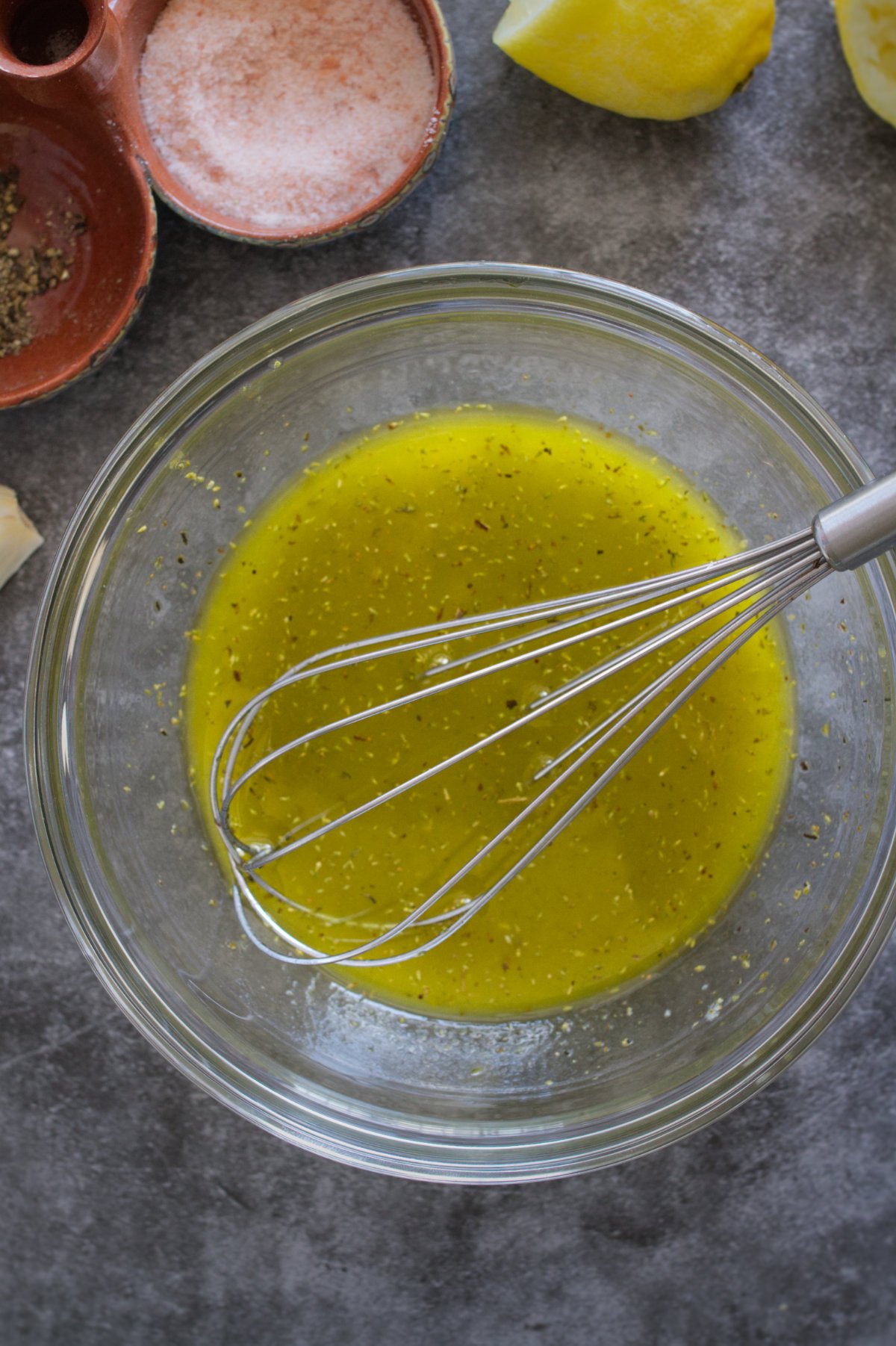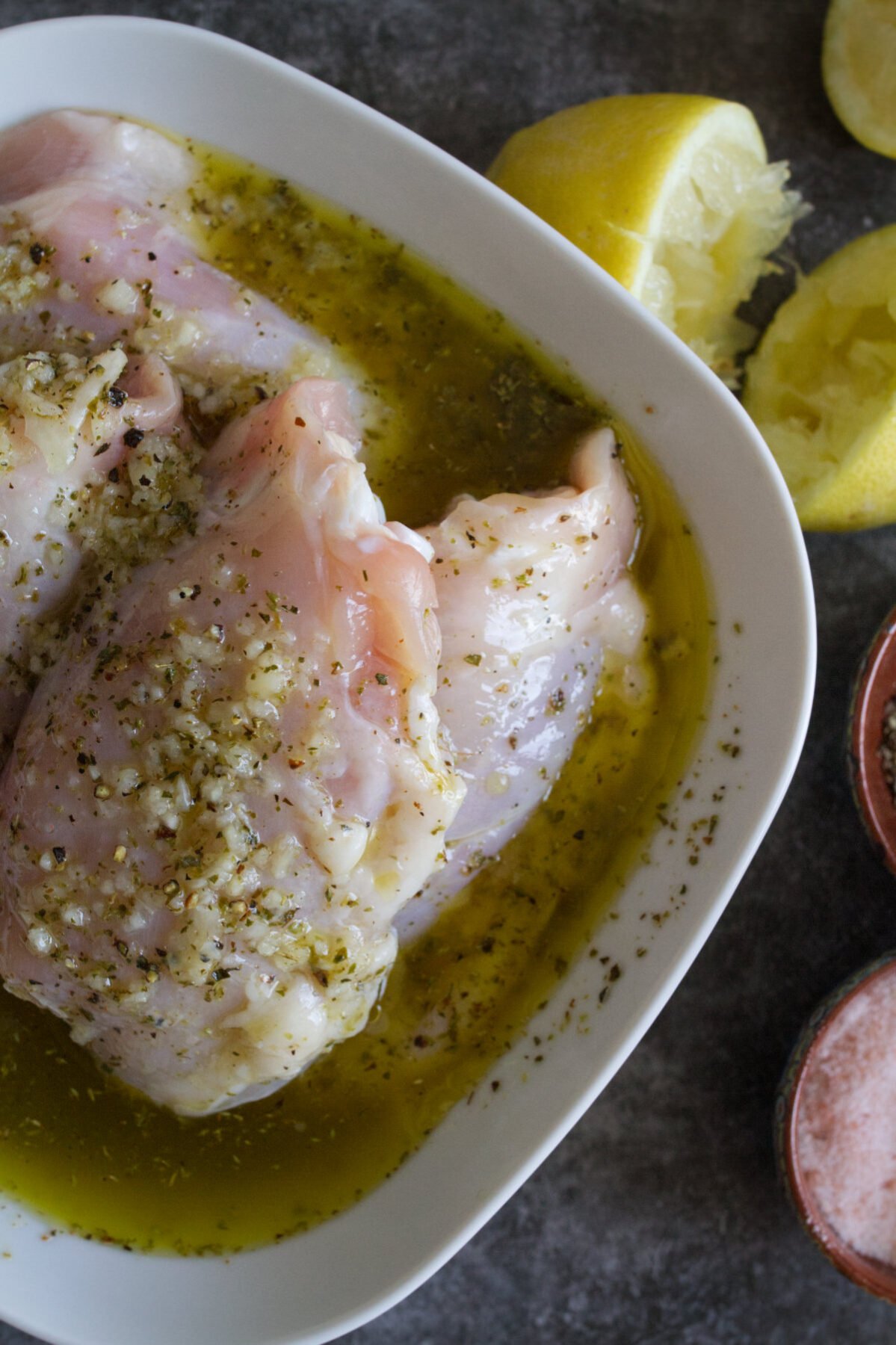The oil-to-acid ratio in Mediterranean marinades is an important factor that affects the flavor and texture of the food being marinated or dressed. A common and effective ratio is 3:1, meaning three parts oil to one part acid. However, this ratio can be adjusted based on the desired taste and the type of food being marinated or the dressing being made.
Table of contents:
Things to Consider When Marinating
When making any type of marinade, it’s important to consider the overall balance of ingredients, and this is where the ratio of 3:1 (3 parts oil to 1 part acid) works so well. No matter whether you’re marinating your favorite meat dish or some tasty veggie on the grill or BBQ, here are some important things to help you achieve the perfect balance and ensure proper marination.
Here’s a breakdown of how it works and some ways you can adapt a marinade to suit your dish and taste:
1. Standard Ratio: 3:1 (Oil to Acid)
- Three parts oil: Oil helps to coat the food and can carry fat-soluble flavors into it. It also helps to keep the food moist during cooking.
- One part acid: Acid (such as vinegar, citrus juice, wine, or yogurt) helps to tenderize the food by breaking down proteins. It also adds brightness and tanginess to the flavor.
2. Adjusting the Ratio
- More Acid (e.g., 2:1 or 1:1): Increasing the amount of acid can intensify the tangy flavor and enhance the tenderizing effect. This might be suitable for tougher cuts of meat or when a sharper flavor is desired.
- Less Acid (e.g., 4:1): Reducing the acid can be beneficial for delicate foods that might be overpowered by too much acidity, like fish or certain vegetables.
3. Components of a Marinade
- Oil: Can be olive oil, vegetable oil, sesame oil, or other oils. The type of oil can influence the flavor profile.
- Acid: Common acids include vinegar (balsamic, apple cider, red or white wine vinegar), citrus juices (lemon, lime, orange), wine, or buttermilk/yogurt.
- Aromatics and Seasonings: Herbs, spices, garlic, onion, soy sauce, mustard, honey, etc., add complexity and depth to the marinade.
4. Examples of Marinades
- Mediterranean Marinade: Olive oil, lemon juice, garlic, oregano, salt, and pepper.
- Asian Marinade: Vegetable oil, rice vinegar, soy sauce, ginger, garlic, and a bit of honey.
- BBQ Marinade: Vegetable oil, apple cider vinegar, garlic, brown sugar, and smoked paprika.
5. Marinating Time
- Short Time (15 minutes to 2 hours): Suitable for fish, seafood, and tender vegetables.
- Moderate Time (2 to 6 hours): Good for poultry and softer cuts of meat.
- Long Time (6 to 24 hours): Best for tougher cuts of meat that need more time to tenderize.
6. Tips for Successful Marinating
- Even Coating: Ensure the food is evenly coated with the marinade.
- Refrigeration: Always marinate in the fridge to prevent bacterial growth.
- Marinade Safety: When marinating meat, discard used marinade or boil it before using it as a sauce to kill any bacteria from the raw meat.
- Puncturing Meat: For thicker cuts, you can puncture the meat slightly with a fork to allow deeper penetration of the marinade.
Adjusting the oil-to-acid ratio based on the food and desired outcome can help you achieve the perfect balance of flavor and tenderness in your dishes. Play around with them and find your favorite combo.

Best Containers for Marinating
When choosing containers for marinating, it’s essential to consider materials that are non-reactive, easy to clean, and practical for handling and storage.
- Best Choices: Glass containers, food-grade plastic bags, stainless steel containers, ceramic containers, and silicone bags.
- Avoid: Aluminum and copper containers.
The best container options for marinating:
1. Glass Containers
- Benefits:
- Non-Reactive: Won’t react with acidic marinades.
- Easy to Clean: Non-porous and dishwasher safe.
- Transparent: Allows you to see the contents easily.
- Temperature Resistant: Can often go from fridge to microwave or oven.
- Examples: Glass bowls with lids, and glass baking dishes with covers.
2. Food-Grade Plastic Bags
- Benefits:
- Space-Efficient: Can be squeezed to remove air, making them compact in the fridge.
- Even Coating: Ensures marinade is evenly distributed around the food.
- Examples: Resealable zip-top bags, and vacuum-sealable bags.
3. Stainless Steel Containers
- Benefits:
- Durable: Long-lasting and resistant to staining and odors.
- Non-Reactive: Safe for use with acidic ingredients.
- Temperature Resistant: Can be used in the fridge, freezer, and sometimes the oven.
- Examples: Stainless steel mixing bowls with lids, and stainless steel marinating trays.
4. Ceramic Containers
- Benefits:
- Non-Reactive: Safe for use with acidic ingredients.
- Aesthetic Appeal: Often attractive for serving as well as marinating.
- Temperature Resistant: Can go from fridge to oven.
- Examples: Ceramic baking dishes, and ceramic bowls with lids.
5. Silicone Bags and Containers
- Benefits:
- Non-Reactive: Safe with acidic marinades.
- Reusable: Eco-friendly and durable.
- Flexible: Easy to store and handle.
- Examples: Silicone food storage bags, and silicone containers with lids.
Practical Tips:
- Cover Properly: Ensure containers are covered to prevent contamination and odor transfer. Use lids, plastic wrap, or foil as needed.
- Size Appropriately: Choose containers that fit the amount of food you’re marinating. This helps ensure even coating and better storage in the fridge.
- Avoid Certain Materials: Steer clear of aluminum or copper containers as they can react with acidic ingredients and impart off flavors or harmful substances.
Things to Consider When Making Dressings
Dressings work on a similar principle and changing the following components helps make the right dressing for a particular dish.
Standard Ratio: 3:1 (Oil to Acid)
- Three parts oil: Creates a smooth, rich base that coats vegetables well.
- One part acid: Adds brightness and a tangy balance to the oil.
Variations
- More Acid (2:1 or 1:1): For a zippier, lighter dressing. Common in vinaigrettes where a sharper flavor is desired.
- Less Acid (4:1): For creamier dressings or when using stronger acids.
Components
- Oil: Olive oil (extra virgin for flavor), vegetable oil, Walnut Oil, etc.
- Acid: Vinegars (red wine, white wine, balsamic, sherry), citrus juices (lemon, lime, orange).
Dressing Examples
- Basic Vinaigrette: Olive oil, red wine vinegar, Dijon mustard, honey, salt, pepper.
- Citrus Dressing: Olive oil, lemon juice, honey, Dijon mustard, salt, pepper.
- Balsamic Vinaigrette: Olive oil, balsamic vinegar, garlic, Dijon mustard, salt, pepper.
Tips for Dressings
- Emulsification: For a stable mixture, whisk or blend the oil and acid with an emulsifier like mustard, honey, or garlic.
- Seasoning: Adjust salt, pepper, and other spices/herbs to taste.
- Freshness: Use fresh ingredients for the best flavor, especially for the acids (fresh citrus juices, quality vinegars).
Enjoy playing around with dressings and finding your favorites!

More Healthy Mediterranean Recipes:
- Beet and Quinoa Salad with a Lime and Mustard dressing
- Mediterranean Pasta Salad + Tangy Lemon Herb Vinaigrette | Easy 20-Minute Recipe
- Fresh & Healthy Horiatiki Greek Salad + Easy Dressing Recipe
- Tabbouleh Salad Recipe: Light, Refreshing, and Delicious
- Classic Greek Salad with Kalamata Olives and Feta Cheese (Easy 5-Minute Recipe)
- Watermelon Salad with Feta Cheese (Easy Summer Salad Recipe)

